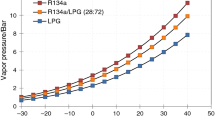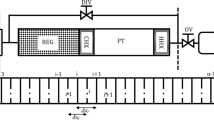Abstract
In this work, an experimental investigation is carried out with R134a and LPG refrigerant mixture for depicting mass flow rate through straight and helical coil adiabatic capillary tubes in a vapor compression refrigeration system. Various experiments were conducted under steady-state conditions, by changing capillary tube length, inner diameter, coil diameter and degree of subcooling. The results showed that mass flow rate through helical coil capillary tube was found lower than straight capillary tube by about 5–16%. Dimensionless correlation and Artificial Neural Network (ANN) models were developed to predict mass flow rate. It was found that dimensionless correlation and ANN model predictions agreed well with experimental results and brought out an absolute fraction of variance of 0.961 and 0.988, root mean square error of 0.489 and 0.275 and mean absolute percentage error of 4.75% and 2.31% respectively. The results suggested that ANN model shows better statistical prediction than dimensionless correlation model.














Similar content being viewed by others
References
Bansal PK, Rupasinghe AS (1996) An empirical model for sizing capillary tubes. Int J Refrig 19(8):497–505
Jung D, Park C, Park B (1999) Capillary tube selection for HCFC22 alternatives. Int J Refrig 22(8):604–614
Chen SL, Liu CH, Cheng CS, Jwo CS (2000) Simulation of refrigerants flowing through adiabatic capillary tubes. HVAC R Res 6(2):101–115
Trisaksri V, Wongwises S (2003) Correlations for sizing adiabatic capillary tubes. Int J Energy Res 27:1145–1164
Choi J, Kim Y, Kim HY (2003) A generalized correlation for refrigerant mass flow rate through adiabatic capillary tubes. Int J Refrig 26(8):881–888
Jabaraj DB, Kathirvel AV, Lal DM (2006) Flow characteristics of HFC407C/HC600a/HC290 refrigerant mixture in adiabatic capillary tubes. Appl Therm Eng 26:1621–1628
Park C, Lee S, Kang H, Kim Y (2007) Experimentation and modeling of refrigerant flow through coiled capillary tube. Int J Refrig 30:1168–1175
Punia SS, Singh J (2015) An experimental study of the flow of LPG as refrigerant inside an adiabatic helical coiled capillary tube in vapour compression refrigeration system. Heat Mass Transf 51(11):1571–1577
Javidmand P, Hoffmann KA (2015) Numerical-based non-dimensional analysis of critical flow of R-12, R-22, and R-134a through horizontal capillary tubes. Int J Refrig 58:58–68
Dan Z, Guoliang D, Xu Y (2017) Development of correlation for mass flow rate through varying diameter capillary tube. CIESC J 68(1):57–62
Gill J, Singh J (2017) Adaptive neuro-fuzzy inference system approach to predict the mass flow rate of R134a/LPG refrigerant for straight and helical coiled adiabatic capillary tubes in the vapor compression refrigeration system. Int J Refrig 78:166–175
Solomon S (ed) (2007) Climate change 2007-the physical science basis: Working group I contribution to the fourth assessment report of the IPCC (Vol. 4). Cambridge University Press, Cambridge
Sekhar SJ, Lal DM (2005) HFC134a/HC600a/HC290 mixture a retrofit for CFC12 systems. Int J Refrig 28:735–743
Mohanraj M, Muraleedharan C, Jayaraj S (2011) A review of recent developments in new refrigerant mixtures for vapor compression based refrigeration, air conditioning and heat pump units. Int J Energy Res 35(8):647–669
Akash BA, Said SA (2003) Assessment of LPG as a possible alternative to R-12 in a domestic refrigerator. Energy Convers Manage 44:381–388
Fatouh M, El KM (2006) Experimental evaluation of a domestic refrigerator working with LPG. Appl Therm Eng 26:1593–1603
Ahamed JU, Saidur R, Masjuki HH, Sattar MA (2012) Energy and thermodynamic performance of LPG as an alternative refrigerant to R-134a in a domestic refrigerator. Energy Sci Res 29(1):597–610
Srinivas P, Chandra RP, Kumar MR, Reddy N (2014) Experimental investigation of LPG as refrigerant in a domestic refrigerator. J Mech Eng Res Technol 2(1):470–476
Taiwo Babarinde OS, Ohunakin DS, Adelekan SA, Oyedepo AS (2015) Experimental study of LPG and R134a refrigerants in vapor compression refrigeration. Int J Energy Clean Environ 16(1–4):71–80
Adelekan DS, Ohunakin OS, Babarinde TO, Odunfa MK, Leramo RO, Oyedepo SO, Badejo DC (2017) Experimental performance of LPG refrigerant charges with varied concentration of TiO2 nano-lubricants in a domestic refrigerator. Case Stud Therm Eng 9:55–61
Mohamed EM (2015) Energy and exergy analysis of LPG (liquefied petroleum gas) as a drop in replacement for R134a in domestic refrigerators. Energy 86:344–353
Yang Z, Liu B, Zhao H (2004) Experimental study of the inert effect of R134a and R227ea on explosion limits of the flammable refrigerants. Exp Thermal Fluid Sci 28:557–563
Avinash P, Jabaraj DB, Lal DM (2005) Beyond for air conditioners – an outlook. IRHACE J 17:20–23
Tashtoush B, Tahat M, Shudeifat MA (2002) Experimental study of new refrigerant mixtures to replace R12 in domestic refrigerators. Appl Therm Eng 22:495–506
Gill J, Singh J (2017) Energetic and Exergetic performance analysis of the vapor compression refrigeration system using adaptive neuro-fuzzy inference system approach. Exp Thermal Fluid Sci 88:246–260
Zhang C-L (2005) Generalized correlation of refrigerant mass flow rate through adiabatic capillary tubes using the artificial neural network. Int J Refrig 28(4):506–514
Zhang CL, Zhao LX (2007) Model-based neural network correlation for refrigerant mass flow rates through adiabatic capillary tubes. Int J Refrig 30:690–698
Islamoglu Y, Kurt A, Parmaksizoglu C (2005) Performance prediction for nonadiabatic capillary tube suction line heat exchanger: an artificial neural network approach. Energy Convers Manag 46:223–232
Vins V, Vacek V (2009) Mass flow rate correlation for two-phase flow of R218 through a capillary tube. Appl Therm Eng 29(14):2816–2823
Shao L-L, Wang J-C, Jin X-C, Zhang C-L (2013) Assessment of existing dimensionless correlations of refrigerant flow through adiabatic capillary tubes. Int J Refrig 36(1):270–278
Cao X, Li ZY, Shao LL, Zhang CL (2016) Refrigerant flows through electronic expansion valve: experiment and neural network modeling. Appl Therm Eng 92:210–218
International Standard Organization (ISO) (1991) International Standard-8187, household refrigerating appliances (refrigerators/freezers) characteristics and test methods. International Organization for Standardization, Geneva
Elmolla ES, Chaudhuri M, Eltoukhy MM (2010) The use of artificial neural network (ANN) for modeling of COD removal from antibiotic aqueous solution by the Fenton process. J Hazard Mater 179:127–134
Author information
Authors and Affiliations
Corresponding author
Rights and permissions
About this article
Cite this article
Gill, J., Singh, J. Depicting mass flow rate of R134a /LPG refrigerant through straight and helical coiled adiabatic capillary tubes of vapor compression refrigeration system using artificial neural network approach. Heat Mass Transfer 54, 1975–1987 (2018). https://doi.org/10.1007/s00231-018-2301-y
Received:
Accepted:
Published:
Issue Date:
DOI: https://doi.org/10.1007/s00231-018-2301-y




